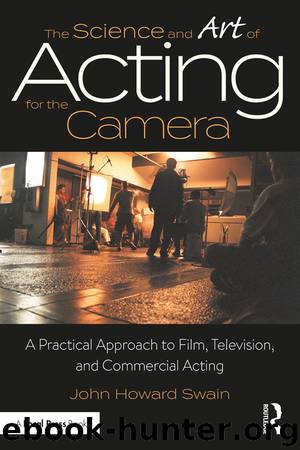The Science and Art of Acting for the Camera by John Howard Swain

Author:John Howard Swain
Language: eng
Format: epub
Publisher: Taylor & Francis (CAM)
Published: 2017-07-11T16:00:00+00:00
p.104
Most actors, however, do just the opposite. They’ll get a script that has a funeral scene in it and then proceed to suck the life right out of it. Why? Because they read the circumstances and leap to the cliché. They forget one of the most important aspects of the scene: that their characters, while they may be sad, while they may be in pain, are also human beings. And if their characters don’t find the humor in a scene, even in a scene where they have come to mourn the death of a dear friend, then they’ll be behaving in an unrealistic manner. If you don’t know how to look for the humor, your performance will become stilted and unreal.
Humor is not reserved for comedies. The heavier the situation, the more humor we need to endure it. Humor is more important in a drama than in a comedy. Again, think of Romeo and Juliet or A Streetcar Named Desire. Both of these classics are tragedies, yet the actors performing in them, in order to deliver the full impact of that tragedy, must employ a tremendous amount of humor in their work.
Actors often confuse humor with jokes. The jokes are where the audience laughs. Humor is where the characters laugh at themselves. Rarely will those two things happen at the same time. If the audience is laughing and your character starts to laugh, the audience will stop laughing because they’re afraid they’ll miss something.
If you don’t instinctively have the gift of “humor,” you need to develop some tools so you can recognize “it” when you see it. If you’re one of those lucky actors whose sense of humor is firmly in place, this next section will help you reinforce what you’re already doing.
There are four elements to finding the humor in a scene. The first is absurdity. What does your character find absurd, despite the seriousness of the moment, either about him/herself or the other character(s) or the situation? What makes him/her think, “I can’t believe I’m doing this,” or, “I can’t believe he just said that,” or, “I can’t believe this is happening?” Once you’ve identified what’s absurd then your ability to laugh at it, regardless of how serious or sacred it may be, becomes easier.
The second is to look for are places where you can break the escalating tension. Tension is a good thing and in our work we oftentimes want to escalate it to a crescendo. There are other times, however, when there’s a need to do the opposite. When things start to get too intense in our real lives, most of us have an automatic release valve, like a pressure gauge, that allows us to blow off steam. We may laugh, often in an inappropriate place, or do any number of things designed to discharge the mounting pressure. If we do it in real life, it is only logical that our characters would do it, too.
Download
This site does not store any files on its server. We only index and link to content provided by other sites. Please contact the content providers to delete copyright contents if any and email us, we'll remove relevant links or contents immediately.
| Acting & Auditioning | Broadway & Musicals |
| Circus | Direction & Production |
| History & Criticism | Miming |
| Playwriting | Puppets & Puppetry |
| Stage Lighting | Stagecraft |
Call Me by Your Name by André Aciman(19033)
Ready Player One by Cline Ernest(12905)
How to Be a Bawse: A Guide to Conquering Life by Lilly Singh(6724)
Wiseguy by Nicholas Pileggi(4632)
The Kite Runner by Khaled Hosseini(4510)
On Writing A Memoir of the Craft by Stephen King(4249)
Audition by Ryu Murakami(4127)
The Crown by Robert Lacey(4127)
Call me by your name by Andre Aciman(4094)
Harry Potter and the Cursed Child: The Journey by Harry Potter Theatrical Productions(4013)
Gerald's Game by Stephen King(3945)
The Perils of Being Moderately Famous by Soha Ali Khan(3796)
Dialogue by Robert McKee(3611)
Dynamic Alignment Through Imagery by Eric Franklin(3512)
Apollo 8 by Jeffrey Kluger(3214)
How to be Champion: My Autobiography by Sarah Millican(3202)
Seriously... I'm Kidding by Ellen DeGeneres(3114)
Darker by E L James(3098)
The Inner Game of Tennis by W. Timothy Gallwey(3019)
